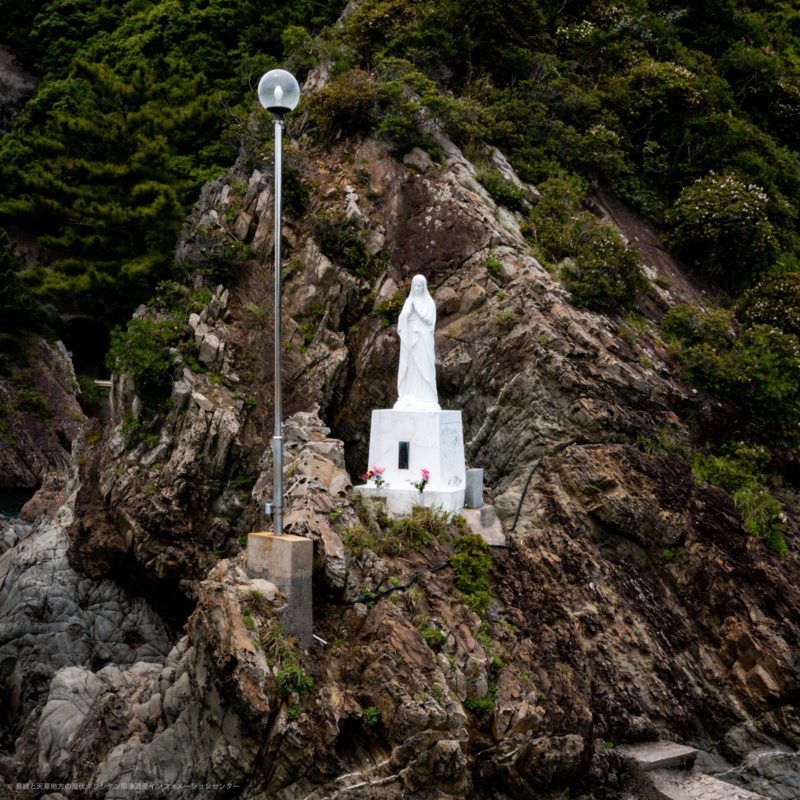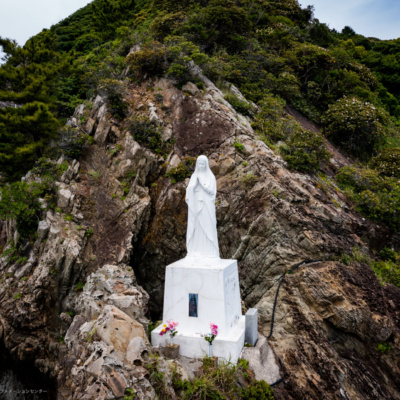Touching history Visiting Churches
Sakitsu Church(Sakitsu Village in Amakusa)

Those wishing to visit must contact Kyushu Sanko Tourism Co.,Ltd.Travel Centre in advance.
Sakitsu Church(Sakitsu Village in Amakusa)
For visitors to Sakitsu Church
The Catholic Sakiatsu Church, located in the component property “Sakiatsu Settlement of Amakusa”, was designed by Father Halbout (Augustin Alphonse Pierre Halbout: 1864-1945), a French priest of the Paris Foreign Missions Society, and was built in 1934.
It is a church in the parish of Sakitsu, Kumamoto Prefecture, which belongs to the Catholic Diocese of Fukuoka, where Mass and various religious events are held on a daily basis.
The Kyushu Sanko Group (Kyushu Sanko Tourism Co.,Ltd.Travel Centre.) provides a system to accept visitors.(during Mass and liturgy times, they may not be allowed in the building)
Cultural assets, etc. included in the constituent assets
| Designation title as cultural assets | Designation category | Designation year |
| Cultural Landscape of Sakitsu and Imatomi in Amakusa | Important Cultural Landscape selected by the national government | Firstly in 2011 and additionally in 2012 |
History of Christianity in the region.

In 1566, Shiki Shigetsune, lord of Shiki Castle in Higo Province, was baptized by the Jesuit missionary Luís de Almeida (1525?-1583). It is said that the purpose of Shigetsune’s baptism was to benefit the Nanban trade, and although he was not so interested in the faith, this event was a catalyst for the spread of Christianity among the people of his domain.
After 1569, a missionary base was established in Kawachiura facing Yokaku Bay, and the Christian feudal lord Yukinaga Konishi, who later became lord of Udo, led to a series of conversions in the Amakusa area.
In 1590, Father Alessandro Valignano (1539-1606), Jesuit priest, came to Japan again, moved the Correggio in Shimabara to Amakusa, and used the Gutenberg printing press brought back by the Tensho mission to print doctrinal books. Western culture spread to Amakusa.
The Amakusa region underwent rapid changes in the ruling system, and after the Christianity ban order, the believers went into hiding to form and maintain a small community of faith.
Changes in Sakitsu Church

The current Sakitsu Church was built in 1934 after Father Halbout’s assignment.
The first church was built in 1888 on land adjacent to the Sakitsu Suwa Shrine, about 80 meters east of the present site, and a wooden building remains on the site.
Designed and built by Yosuke Tetsukawa, the church has a gothic style with a reinforced concrete front and a wooden altar side.
The church was originally planned to be constructed entirely of reinforced concrete, but due to a lack of funds halfway through construction, two-thirds of the building was converted to a wooden structure.The floor of the hall is covered with tatami mats, and soft light shines through the colored plate glass fitted into the openings of the steeple arches.
The Tokugawa shogunate made suspected Christians step on the likenesses of Jesus and Mary to prove that they were not Christians.
The Tokugawa shogunate in Japan forced suspected Christians to step on the likenesses of Jesus and Mary to prove that they were not Christians, which was forbidden.
During the ban on Christianity, every year in the house of the village headman, authorities conducted the e-fumi ceremony, forcing all the residents to trample on an image of Christ or the Virgin Mary to prove that they were not Christians.
The church was built on the site of the Shoya (village headman)’s mansion where the ”e-fumi” took place.
Surroundings and location

It is built on land facing Yokaku Bay on the west shore of Amakusa Shimojima.
People’s houses are densely built on the mountain side across the road from the seaside where the church stands, with terrace-like scaffolding extending out to the sea.
This was born from the wisdom of living in a small area and is called “Kake”.
In addition, between the densely packed houses, there are narrow lanes, called “To-ya”.
These “Kake” and “To-ya” are characteristic of the landscape of the Sakitsu community.
Overview
| Prior notice | Those wishing to visit must contact Kyushu Sanko Tourism Co.,Ltd.Travel Centre in advance. |
| Address | 539 Sakitsu, Kawaura-machi, Amakusa City, Kumamoto |
| Masses/religious events | Please check the official website. https://www.kyusanko.co.jp/ryoko/pickup/sakitsu-church/ |
| Visiting Hours | 9:00~12:00/13:00~17:00 |
| Parking area | Please use free sightseeing parking lot (less than three minutes on foot) of neighborhood. |
Traffic Access

Access Map
Gallery





















